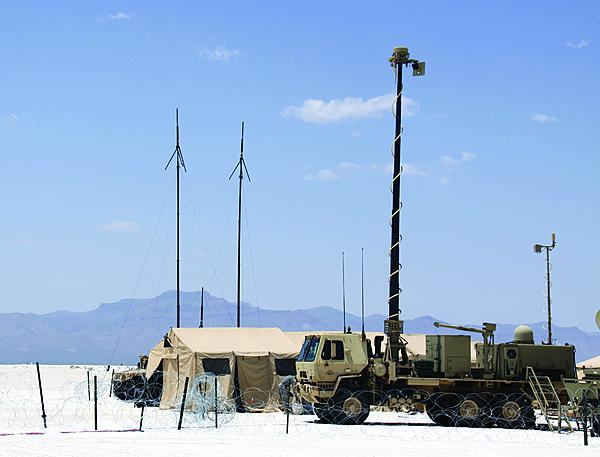Building a Bigger, Better Pipe
Scientists at the U.S. Defense Department’s top research and development agency are seeking the best new ideas to provide a larger-scale mobile network to support an increasing array of bandwidth-hungry mobile computing devices for warfighters.
The Defense Advanced Research Projects Agency (DARPA) has issued a Request for Information (RFI) for new technical approaches that would expand the number and capacity of Mobile Ad Hoc Networks (MANETs) nodes available in the field.
“When we look at MANETs, it’s really tough to deliver networking services to more than about 100 users,” says Mark Rich, program manager, DARPA Strategic Technology Office. Those 100 users translate into approximately 50 nodes on a mobile wireless network operating in a forward location, generally supporting everything from tactical and operational systems to advanced video services. All of these functions are carried on a service that is largely dependent on highly secure digital radio systems. Once that limit is reached, network services begin to deteriorate in quality and effectiveness. To support larger deployments or to cover a greater area, military communications experts usually knit smaller networks using other available means, such as satellites.
“Because we’re constrained to small networks but have growing needs in network sizes and growing needs in capacity, what we’re doing today is piecemealing together lots of smaller networks in order to provide a comprehensive solution,” he explains. “It is a very manual, very labor intensive, very fragile, operating environment. We spend an inordinate amount of time in frequency coordination for multiple networks. We have IT [information technology] professionals who have to manage these things. We use a tremendous amount of manpower to create these larger-scale solutions, and we constrain what each network can do to optimize its performance,” he adds. Over the past two decades, efforts to overcome this limit using current mobile networking technology have been largely unsuccessful.
By comparison, Rich says, commercial Internet service providers (ISPs) can deliver mobile broadband connectivity to thousands upon thousands of users. “When Verizon adds a new customer, it doesn’t impact a user in Kansas,” he explains. To accomplish this task, ISPs use a pre-installed infrastructure that primarily is based on high-speed fiber optic cable networks combined with clusters of digital wireless radio transceivers that employ cellular spread-spectrum technology. The cellular telephone industry acknowledges that aspects of this infrastructure are reaching their own limits in terms of the number of users that can be supported with current digital cellular technology, and research is underway to overcome those limitations (SIGNAL Magazine, “MultiAntenna Research...,” December 2012).
The DARPA RFI seeks input from researchers in the military, government, academic and private research lab sectors in three primary areas: fundamental understanding of the limits of current networking technology; ways to modify the use of MANETs to improve service to warfighters; and improved methods of delivering networking technology.
The RFI is a clean-slate approach to finding innovative technologies and techniques to overcome limits on MANETs. “Are there things we could do differently?” asks Rich. “What are the fundamental limitations on what we deliver, and who we could deliver it to?” He adds that DARPA wants to go beyond the status quo and make it possible to build MANETs around ground-breaking technologies that could expand capacity by a factor of as much as 20. “We really want to get a discussion going,” Rich says. “We’re looking for a breadth of capability and unique insight that can be used to get the creative juices flowing.”
Rich acknowledges that the RFI might yield a more effective mobile networking technology developed for commercial ISPs that could be adapted to the military MANET. “If there is truly something out there that we haven’t taken advantage of, then yes, we’d definitely be open to that,” he says. But Rich goes on to stress that ultimately, the RFI is all about new ways of facilitating the use of mobile networking. “We’re trying not to do a program that builds upon an existing capability, whether that’s military or commercial. We’re trying to find what may be new and different, a new approach,” he adds.
Much of the reason MANETs are unable to scale beyond supporting 50 nodes at a time can be traced to the fact that so much of the technology is based on technical protocols developed during the early days of the Internet, or what Rich calls the wired world. The capabilities are fundamentally different. Wires have much more capacity and less interference. Compare that, he says, with a military MANET system that is predominately wireless.
“We have to deal with a great deal of interference from ground systems, as well as other [electronic] noise sources in the local area. And fundamentally, we’re trying to eke out as much of the fundamental radio capacity as possible for the delivery of service,” Rich explains. He adds that over the last several decades, most of those protocols have been fine-tuned and adapted to MANETs, but they have never been modified to deal with the realities of wireless data transmission.
DARPA is open to whatever might be proposed, Rich says. For example, if someone has insights into the basic physics that govern data transmission over a mobile network and has ideas that could overcome the current scaling limitations, he would welcome the opportunity to have authors present their ideas. He also would like to see papers in the realm of compression, caching services or what he calls “reducing the amount of information we need to communicate.”
One of the top priorities of more recent Defense Department information technology initiatives such as the Joint Information Environment is to facilitate the secure sharing of information. Rich says the DARPA RFI is looking for anyone with good ideas in this area as well. “One of the things we’ve said is, don’t be constrained by the network routing techniques we have today,” explains Rich. He urges those submitting paper abstracts to look beyond the most recent developments such as Internet protocol (IP) convergence, better known as unified communications, which allows voice, data, video and other services to travel simultaneously on the same IP-based connection. “Might this be constraining us and confining us in terms of what we might do in the ‘ad hoc’ world? Is this the right kind of convergence? How do we define the kind of convergence that we need?” he asks rhetorically.
Looking ahead, Rich says DARPA wants the RFI to result in some novel ideas that will allow warfighters to deploy with more than just a handful of networks with nominal capabilities Rich explains that a next-generation network based on the findings of the RFI would be welcome news to the military. In an ideal world, such a network could be configured to support thousands of warfighters simultaneously, while offering improvements in bandwidth availability and ease of maintenance.
In fact, a more rigorous network would enable more effective use of mobile devices now in development, devices that would allow individual soldiers to share the same tactical mission information. “If we can create these larger-scale networks that can provide these improved services, it’s going to enable us to have much more communication capabilities than we have in the battlefield today. It will enable more of the sensor systems that we have become reliant upon. And it will enable deployment of new technologies in the future,” Rich concludes. Those technologies would include wider use of tactical video information systems; improved situational awareness; applications that take advantage of big data; and applications that facilitate interactions between manned and unmanned systems.






Comments